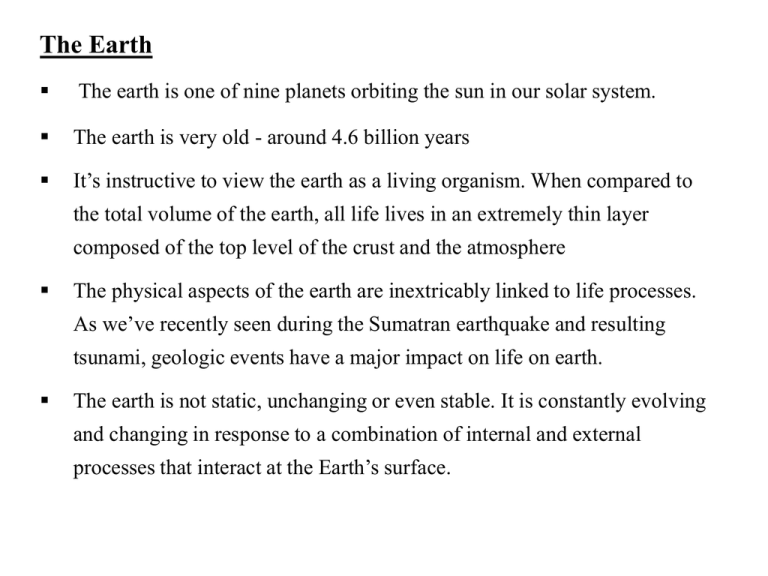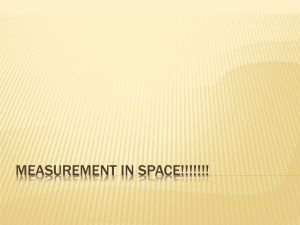The Earth
advertisement

The Earth The earth is one of nine planets orbiting the sun in our solar system. The earth is very old - around 4.6 billion years It’s instructive to view the earth as a living organism. When compared to the total volume of the earth, all life lives in an extremely thin layer composed of the top level of the crust and the atmosphere The physical aspects of the earth are inextricably linked to life processes. As we’ve recently seen during the Sumatran earthquake and resulting tsunami, geologic events have a major impact on life on earth. The earth is not static, unchanging or even stable. It is constantly evolving and changing in response to a combination of internal and external processes that interact at the Earth’s surface. Internal processes are primarily driven by heat contained inside the earth. Internal heat drives plate movement (plate tectonics) which, in turn, are the cause of most volcanic eruptions, earthquakes, and mountain building, as well as the creation of new land surface at mid-ocean ridges. There, hot molten rock called magma that is created from deep within the earth makes its way to just below or above the sea floor to become new oceanic crust. External processes include the sun’s radiation. Radiant energy from the sun drives air (wind) and water movement (evaporation and the hydrologic or water cycle). Those factors, in turn, act upon the earth’s surface to continually erode it. Radiant energy from the sun also provides the energy for photosynthesis upon which most life on earth depends. Chapter 1 • Scientists calculate that the universe (which some believe has a flat geometry) is about 13.7 billion years old. • They calculate the age of the universe by the predictable rate at which stars cool and the relationship between star cooling rate and the light they emit or luminosity (star brightness or dimness). • The color of the light emitted by exploding stars in far-off galaxies also provide a measure of distance (“redshift”). • Using redshift effects, scientists can also calculate the age of the universe by measuring how fast galaxies are speeding away from each other. Big Bang Theory • The Big Bang theory is a a widely accepted cosmological model (introduced in the late 1970’s) also called the inflationary model or expanding universe theory. • In this model, the universe was born in an instantaneous creation of matter and energy known as the Big Bang. • One modification of the B.B theory suggests that the universe undergoes a cyclic period of expansion and contraction and that these cycles are caused by a mysterious force that scientists believe permeates the entire universe, a force that is called “dark energy”. • It seems that the expansion of the Universe is accelerating and being pushed outward when normal gravitational theory would predict that the Universe would start to contract (due to the relationship between mass and gravity) after the initial expansion. • The composition of the Universe is estimated to consist of 23% dark matter and 73% dark energy. Everything else that we can see (the visible universe), including galaxies, stars, and us, makes up just 4%. • Dark matter is postulated to exist because astronomers can see its effects on stars and galaxies. Dark energy, sometimes called “quintessence”, is a phantom force because scientists don’t know exactly what it is or what it is made up of. • Relativity theory predicts that all mass distorts the space around it. Therefore, when light from distant objects passes close to dark matter, it becomes “bent”, an effect called gravitational lensing. • Scientists don’t know what makes up dark matter, only that there is “something” out there that has these effects. • According to this model, the Big Bang is a transition between two cycles in an endless process of cosmological rebirth. This new model needs to be tested by studying other cosmic phenomena like gravitational waves, for example, a feature of the universe predicted by general relativity. In a cyclic universe, there would be no long-wavelength gravitational waves but in an inflationary universe, they would exist. What early Western civilizations believed about the Earth and the Solar System • The early Greeks believed the earth to be a flat disk at the center of a celestial sphere that lay beneath a huge dome. Starts were attached to the top of the dome and Hades, the dreaded underworld, lay below. • Later, Greek philosophers argued about the structure of the Universe and some observers popularized the geocentric Universe concept. • The geocentric concept conceived of a motionless Earth in the middle of the heavens around which other celestial bodies orbited. • Around 250 B.C.E., other Greek philosophers proposed the heliocentric Universe concept where the Earth and other heavenly bodies orbited around the Sun. • The correct idea of a heliocentric Universe was discarded in favor of the incorrect geocentric Universe due to the influence of an Egyptian mathematician called Ptolemy, who lived from 100-170 C.E.. Ptolemy resurrected the geocentric view. • The church hierarchy adopted this view as dogma because it confirmed their own view that the Earth was the most important place in the Universe and human beings the Universe’s most important creatures. (Also, at the time, most people believe the Earth was flat, not spherical, and that if you sailed on the ocean too far in one direction you would fall off the edge). • For the next thousand or more years, anyone that disputed the geocentric view risked his/her life by accusations of heresy. This definitely put a damper on scientific thought and experimentation during the time period. • However, despite the continuing efforts of church leaders to suppress scientific ideas that conflicted with their own beliefs, the Renaissance occurred anyway. • Toscanelli, an Italian astronomer (1397-1482) reported the Earth was round. This theory influenced Christopher Columbus who took that information to the King and Queen of Spain (remember Isabella and Ferdinand?) and persuaded them that he could sail west to the Indies via the Atlantic Ocean and would not fall off the edge of the known world, as many thought. • Columbus didn’t make it to the Indies because he ran into the North American continent, but that’s another story. • The rebirth and vitality of the Rennaissance revolutionized scientific thought. • Copernicus (1473-1543) re-introduced the heliocentric concept, which was then proven by Galileo’s observations (1564-1642). • Copernicus wrote about his heliocentric concept in a book but didn’t allow it to be published until a few days before his death because he feared the church’s reaction. • Galileo, using the newly invented telescope, observed that Jupiter had orbiting moons, which was proof that not all heavenly bodies orbited around the earth. • As a result of Galileo’s heretical ideas, he spent the last ten years of his life under house arrest. He was fortunate that he wasn’t put to death. • Issac Newton (1642-1727) introduced physical and mathematical laws that allowed further insight into universal movement such as gravity. The solar system • The earth is one of nine planets in our solar system. • The Sun is one of over 300 billion stars that form the Milky Way galaxy. Our Sun is located on one of the spiral arms of the Milky Way galaxy. • The Milky Way itself is one of 100 billion galaxies that comprise the visible Universe. If we could view the Milky Way from a great distance, it would look like a flattened spiral, 100,000 light years across. (A light year is the distance that light travels in one Earth year, about 9.5 trillion km [about 6 trillion miles]). The Doppler Effect • Example of the Doppler Effect: when a train moves toward you, the pitch of the sound has a higher frequency (sound waves closer together) because the source of the sound is moving closer to you. When the train moves away from you, the sound has a lower frequency (waves farther apart). • For light, red light has a longer wavelength (lower frequency) than blue light (higher frequency). If the light source moves away from you, the light will become redder (as the light shifts to a lower frequency) and if the light source moves towards you, the light will become bluer (as the it shifts to a higher frequency). This is called the red shift and the blue shift. • After the B.B., matter could not exist in any form because it was so hot. • After one second, the University had expanded and cooled to about 5 billion degrees Celsius, which allowed protons and neutrons to form. • 800,000 years later, the Universe cooled enough for hydrogen and helium atoms to form. • One million years after the B.B., the Universe was a cloud of these atoms. This kind of cloud is called a nebula. • The initial nebula had differing areas of density which allowed this cloud of gas to clump into separate nebulae. Gravity caused clumps of gas in the nebulae to coalesce into dense, revolving balls. Centrifugal force caused the spinning cloud of gas to form into a disk with a spherical core that eventually continued to collapse inward and become a protostar. • As the density of the protostar increased, temperatures increased to millions of degrees, causing the nuclei of the hydrogen atoms to fuse. • Most of the 92 elements today formed during the life cycle of a star. Only hydrogen and helium (light elements) formed during the early stages of the Universe. • Planets are made from planetesimals; originally the rings of gas and dusk surrounding a protostar. The Moon formed when another celestial body collided with the Earth to create a massive cloud of dust and debris that coalesced to form the Moon. The nebula condenses into a swirling disc, with a central ball surrounded by rings. Forming the solar system, according to the nebula hypothesis: A second- or thirdgeneration nebula forms from hydrogen and helium left over from the big bang, as well as from heavier elements that were produced by fusion reactions in stars or during explosion of stars. The ball at the center grows dense and hot enough for fusion reactions to begin. It becomes the Sun. Dust (solid particles) condenses in the rings. Dust particles collide and stick together, forming planetesimals. Gravity reshapes the proto-Earth into a sphere. The interior of the Earth separates into a core and mantle. Forming the panets from planetesimals: Planetesimals grow by continuous collisions. Gradually, an irregularly shaped proto-Earth develops. The interior heats up and becomes soft. Soon after Earth forms, a small planet collides with it, blasting debris that forms a ring around the Earth. The Moon forms from the ring of debris. Eventually, the atmosphere develops from volcanic gases. When the Earth becomes cool enough, moisture condenses and rains to create the oceans. • In our solar system, solar wind (see picture at right) blew the lighter elements outward to form the Jovian or gas-giant planets. •The rocky and metallic balls towards the inner solar system became the terrestrial planets. • A planet is round because of the forces of gravity that act on the soft rock inside a planet to make it spherical. Relative sizes of the planets in our solar system End of Chapter I


